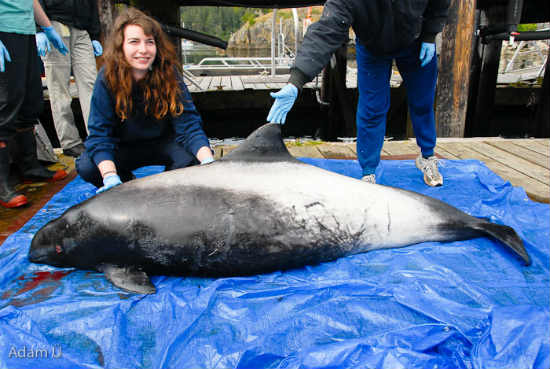Porpoise hybrids
Family Phocoenidae
EUGENE M. MCCARTHY, PHD GENETICS
|
|
Australophocoena dioptrica [Spectacled Porpoise]
× Cephalorhynchus sp. An aberrant dolphin taken at Bahia de Concepción, Chile (37˚ S) was described as a species (Phocoena obtusata) by Philippi (1893). It was 1.5 m long and similar to A. dioptrica, but had white vertical barring extending into the lateral regions, normally black in dioptrica. It also had black pectoral flippers (white in dioptrica). True (1903) thought the fins and head suggested Cephalorhynchus,but not the coloration. Allen (1925a) asserted that it was almost certainly a dioptrica female. Brownell (1975) examined the holotype, which is on display in the Museo Nacional de Historia Natural in Santiago, Chile, and stated (p. 3) that “in my opinion this specimen is a dephinid of the genus Cephalorhychus as True (1903) stated and not P. dioptrica [= A. dioptrica]. My reasons are as follows: 1) the dorsal fin is not phocoenid in shape as figured by Philippi in his plate 3, figure 1 (1893) but its apex is rounded as in all known species of Cephalorhynchus, except C. heavisidii found in South African waters…2) the shape of the flippers of P. obtusata are not like those of P. dioptrica.”
Given the dissent concerning the nature of this specimen, and the fact that it combines characteristics of A. dioptrica with those of Cephalorhynchus, the possibility should be considered that it may be a hybrid between A. dioptrica and some member of the genus Cephalorhynchus, perhaps C. commersonii or C. eutropia (Chilean Dolphin), both of which occur in southern Chilean waters (where the specimen was collected). C. commersonii seems the more likely of the two since it (unlike C. eutropia) has white sides, which would account for the presence of white lateral barring in the putative hybrid. However, such a cross would be quite distant since it would be between taxa currently assigned to different families.
Phocoena phocoena [Harbor Porpoise]
× Phocoena spinipinnis [Burmeister’s Porpoise] The critically endangered Vaquita (Phocoena sinus), known only from the northern Gulf of California, Mexico, is morphologically intermediate between P. phocoena and P. spinipinnis. Although P. sinus is not usually thought to be of hybrid origin, its very rarity, together with its intermediacy, suggest it as a PHP of this cross. P. sinus is also geographically intermediate, but there is a wide hiatus between the northern P. phocoena and southern P. spinipinnis. Neither putative parent is known to occur in the Gulf of California, though there may be sporadic contact along the west coast of Central America (Norris and McFarland mention sightings of Phocoena off the coast of Jalisco). P. sinus is currently treated as a species and accorded critically endangered status, but whether it was formerly more abundant is unknown. It was first described in 1958. The possibility should be considered, then, that the Vaquita may be the product of matings between P. phocoena and P. spinipinnis vagrants (in general vagrants have a greater tendency to hybridize since they are unable to find an appropriate mate). Other organisms treated as endangered species, have turned out to be rare hybrids. A prominent example is the Imperial Pheasant, which was recently found to be the hybrid of two other pheasants (McCarthy 2006). Another factor that fits with this hypothesis is that the P. sinus mtDNA haplotype is entirely invariate (Rosel and Rojas-Bracho 1999) and similar to P. spinipinnis (McGowen et al. 2009). If further research revealed that the P. sinus haplotype fell within the P. spinipinnis range of variation, then an obvious possibility would be that all P. sinus individuals are descended from a single P. spinipinnis female that participated in a hybrid cross. Brownell 1983; Norris and McFarland 1958 (p. 24).

|
| A female Harbor Porpoise × Dall’s Porpoise hybrid. (Access source) |
Phocoena sinus [Vaquita] Phocoena phocoena× P. spinipinnis.
Phocoena spinipinnis [Burmeister’s Porpoise] Phocoena phocoena.
Phocoenoides dalli [Dall’s Porpoise] See: Phocoena phocoena.
By the same author: Handbook of Avian Hybrids of the World, Oxford University Press (2006).